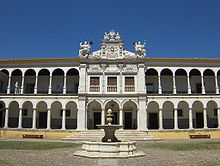University of Évora
Universidade de Évora | |
 | |
| Latin:Universitas Eborensis | |
Former names | Universidade do Espírito Santo Instituto Universitário de Évora |
|---|---|
| Motto | Honesto estudo com longa experiência misturado |
Motto in English | Honest study mixed with long experience |
| Type | Public university |
| Established | 1559 1973a |
| Rector | Ana Costa Freitas |
| Students | 7,800[1] |
| Location | , 38°34′23″N7°54′16″W/ 38.5731°N 7.9044°W |
| Campus | Urban |
| Colours | burgundyandwhite |
| Affiliations | Compostela Group EUA UNIMED |
| Website | uevora.pt |
aReestablished after its closure in 1779. | |
TheUniversity of Évora(Universidade de Évora) is apublic universityinÉvora,Portugal.It is the second oldest university in the country, established in 1559 by thecardinal Henry,and receiving University status in April of the same year fromPope Paul IV,as documented in hisCum a nobispapal bull.[2]Running under the aegis of theSociety of Jesus(also known as Jesuits) meant that the university was a target of theMarquis of Pombal'sJesuit oppression,being closed down permanently in 1779 and its masters either incarcerated or exiled.[3]
It was reopened nearly two hundred years later in 1973 asInstituto Universitário de Évora(University Institute of Évora) by decree of the Minister of Education, José Veiga Simão, in the site of the older university,[4]as part of a set of education policies during the early 1970s that were attempting to reshape Portuguese higher education.[5]Six years later, in 1979, the name was changed toUniversidade de Évora.[3]
History[edit]
The University of Évora, the second oldest in Portugal, was founded in the 16th century by the Archbishop of ÉvoraCardinal Infante Dom Henrique,futureking of Portugal,and thePope Paul IV.Its administrative control was granted to the newly formedSociety of Jesus.[3]This measure could be seen as part of Henry's policies to attract Jesuits to the kingdom.[citation needed]
The Jesuitcollegein Évora operated between 1559 and 1759, when it was surrounded by cavalry troops on February 8 of 1759, as a consequence of theJesuit banishmentpromoted by the Minister of the KingdomMarquis of Pombal.[3]

TheColégio do Espírito Santobecame famed as a centre of learning and rivalled theUniversity of Coimbra.Among its eminent theologians and philosophers wereLuis de Molina(1535-1600),Pedro de Fonseca(1528-1599), St. Francisco de Borja, St.João de Brito,Manuel Álvares.Several prelates of thePortuguese Empirewere trained at this university: D.Afonso Mendes,Patriarch of Abyssinia, and D. Pedro Martins, first bishop of Japan. The classrooms are decorated with appropriateazulejos(ceramic tiles) such as "Platoteaching his followers "and"AristotleteachingAlexander the Great".
The University of Évora resumed work in 1973 as a state-run university. The diplomas are granted in the 18th centuryBaroquechapel (Sala dos Actos) (restored in 1973), that dominates theTuscan-arched Renaissancecloister.
See also[edit]
- List of early modern universities in Europe
- List of Jesuit sites
- List of universities in Portugal
- Higher education in Portugal
References[edit]
- ^About (2024).The University of Évora.Retrieved online 10.02.2024https:// uevora.pt/en/university
- ^"história".uevora.pt(in Portuguese).Retrieved2015-03-08.
- ^abcd"a universidade".uevora.pt(in Portuguese).Retrieved2015-03-08.
- ^"Universidade de Évora – Colégio do Espírito Santo".visitevora.net(in Portuguese). 18 January 2014.Retrieved2015-03-08.
- ^"A reforma do ministro" subversivo "".expresso.sapo.pt(in Portuguese). 3 May 2014.Retrieved2015-03-08.
External links[edit]
- University of Évora
- Évora
- Universities and colleges established in 1973
- Jesuit universities and colleges
- 1559 establishments in Portugal
- Baroque architecture in Portugal
- 1973 establishments in Portugal
- Buildings and structures in Alentejo Region
- Educational institutions established in the 1550s
- 1779 disestablishments in Portugal
- Educational institutions disestablished in the 1770s
- National monuments in Évora District
- Portuguese building and structure stubs
- Europe university stubs
